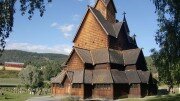The Borgund Stave Church dates back to the late 12th century and it’s one of the most internationally renowned Norwegian buildings. Read on for our full visitor’s guide – plus all the background information you need to know about this fascinating church.
The Borgund Stave Church (also known as the Borgund stavkirke) was first built around 1180 and dedicated to Andrew the Apostle. It sits in the village of Borgund, Norway, 56 km from Flåm and 167 km from Bergen.
Let’s set the scene with an introduction about how the fascinating Borgund stavkirke came to be.
Borgund Stave Church: A history
Wondering why a former Christian church has such a Viking-looking aesthetic? To explain, we’ve gotta take it back in time a little over a millennium; to the Viking age (roughly lasting from the 8th century to the 11th century).
During the Viking Age in Norway, pagan Viking religion was prevalent. The Vikings were polytheistic, and though much of their pantheon has been reconstructed quite vividly thanks to written sources, we don’t know many details about their religious sites and rites.
Services like mass and buildings like churches, to our knowledge, didn’t exist in Viking religions – though there is some evidence of possible cultic activity sites. We believe most of their worship took place in the home or in nature.
Then came Olaf II Haraldsson (c. 995 – c. 1030), who is a big part of the reason why there even are churches in Norway today.
Olaf was brought up as a Viking warrior but converted to Christianity during his travels in Europe, and was baptized in France. He returned to Norway, conquering lands, and ended up ruling as king of all Norway from 1016-1028.
During his rule, Olaf attempted to establish Christianity as the main – and only – religion in Norway, often using violent methods. He also created an official religious code.
Olaf was driven out of Norway in 1028 by King Canute I of England and Denmark (990-1035), who entered the land attempting to conquer it. Olaf returned two years later hoping to regain power.
He was killed soon after arriving. His death was associated with miracles – he was canonized locally in 1031 and officially by the pope in 1164.
In the years following Olaf’s death, Christianity increasingly spread throughout the Nordic countries and by the end of the 12th century, it was the most prevalent religion in the entire region.
The push-and-pull between the Christian and Viking religions throughout the centuries resulted in Norway’s fascinating stave churches, which were built during the crossroad 12th century.
The stave churches are the result of a transitional blend between Christian and Viking ideas and architecture. There were once hundreds of such churches. Today, just over 20 remain.
Which brings us back to the Borgund Stave Church.
The importance of the Borgund Stave Church
During the 12th century, Borgund, Norway was the first town-like trade settlement in the surrounding district of Sunnmøre. People from villages in the area likely relied heavily on Borgund as the nearest large marketplace to sell their goods which included fish and fur.
Between Bergen and Nidaros, today known as Trondheim, Borgund and its stavkirke were also the largest religious centers up until the 14th century.
This Christian stavkirke was the parish church of Vestland County’s Lærdal Municipality until 1868. In 1877, the church was purchased by the National Trust of Norway in order to save it from demolition and maintain it. And so, the extremely well-preserved church proudly flaunts its intricately engraved portals and carvings of dragon heads to this day.
Borgund Stave Church has been converted into a modern-day museum. It houses a permanent exhibition presenting Viking history and artifacts. Onsite, the church also features a restaurant, souvenir shop, quiet room, and further exhibitions about the interesting history of stave churches in Norway.
Borgund Stave Church’s international stardom
Along with the UNESCO-protected Urnes Stave Church, this is one of Norway’s most well-known religious buildings.
The breathtaking Borgund Stave Church architecture, and its elaborately carved dragon heads, are of both national and international fame.
There’s even another stavkirke in Norway, the Hopperstad Stave Church, that was remodeled in part after the Borgund Stave Church.
Hopperstad Stave Church had been neglected, taken apart, and was generally in poor standing up until 1881. Then, it underwent a total renovation, drawing much inspiration from the Borgund Stave Church – especially in its external gallery and ridge turret.
You’ll also find one Borgund Stave Church replica in Germany and two in the United States.
This stavkirke has been immortalized in other ways, as well. Popular video games feature architecture inspired by the church.
One of these is The Elder Scrolls V: Skyrim, a role-playing game by Bethesda Studios which often draws on Viking culture. In Skyrim, the Temple of Kynareth (the in-game goddess of the heavens and winds) bears a striking resemblance to Borgund stavkirke.
The Borgund Stave Church’s Minecraft (a sandbox video game currently run by Mojang Studios) debut is big, too.
It’s the subject of numerous YouTube Minecraft building tutorials, and a popular architectural recreation by many players.
Visiting Borgund Stave Church: Logistics
Ready to visit yet?
Here’s the full logistics lowdown on the Borgund Stave Church (at the time of writing).
Borgund Stave Church opening hours:
- From June 1 to September 30, the church is open Monday, Tuesday, Wednesday, Thursday, Friday, Saturday, and Sunday from 10 AM to 5 PM.
Tickets:
- Adult: 100 kroner
- Children: 80 kroner
- Family: 240 kroner
- Groups of 15+: 90 kroner
- Student: 80 kroner
- Retiree: 90 kroner
Address:
- Vindhella 606, 6888 Borgund, Norway
Tours:
- Guided tours of the Borgund Stave Church are available.
Amenities:
- Restaurant
- Souvenir shop
- Parking
- Toilets
Contact email:
Make sure to double-check the church’s website for all details before planning your visit.
Source: Norway Today





Leave a comment